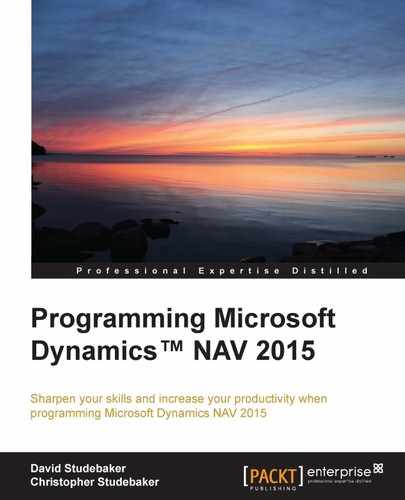Book Description
Sharpen your skills and increase your productivity when programming Microsoft Dynamics NAV 2015
In Detail
NAV 2015 is a complete ERP system, which also contains a robust set of development tools to support customization and enhancement. These include an object designer for each of seven application object types, a business application-oriented programming language with .NET interface capability, a compiler, a debugger, and programming testing language support.
This book is designed to take you from an introduction to the product and its integrated development tools to being a productive developer in the NAV 2015 environment. It will serve as a comprehensive reference guide, complementing NAV's Help files. You will find this book really useful if you want to evaluate the product's development capabilities or need to manage NAV 2015 based projects. Additionally, you will also learn about the NAV application structure, the C/SIDE development environment, the C/AL language, the construction and uses of each object type, and how it all fits together.
What You Will Learn
- Extract and utilize NAV data using queries and reports
- Use the integrated debugger, the .NET interface, and C/AL extensions for automated testing
- Understand NAV's data element choices, properties, and usages
- Discover how to successfully deliver an interactive user data presentation
- Sharpen your skills and increase your productivity with Microsoft Dynamics NAV
- Get to grips with the fundamental programming and design concepts of Microsoft Dynamics NAV 2015
Downloading the example code for this book. You can download the example code files for all Packt books you have purchased from your account at http://www.PacktPub.com. If you purchased this book elsewhere, you can visit http://www.PacktPub.com/support and register to have the files e-mailed directly to you.
Table of Contents
- Programming Microsoft Dynamics™ NAV 2015
- Table of Contents
- Programming Microsoft Dynamics™ NAV 2015
- Credits
- Foreword
- About the Authors
- Acknowledgments
- About the Reviewers
- www.PacktPub.com
- Preface
- 1. An Introduction to NAV 2015
- NAV 2015 – an ERP system
- Significant changes in NAV 2015
- A developer's overview of NAV 2015
- Hands-on development in NAV 2015
- Summary
- Review questions
- 2. Tables
- An overview of tables
- Enhancing our sample application
- Creating and modifying tables
- Assigning a Table Relation property
- Assigning an InitValue property
- Adding a few activity-tracking tables
- New tables for our WDTU project
- New list pages for our WDTU project
- Keys, SumIndexFields, and table relations in our examples
- Modifying a standard table
- Version list documentation
- Types of tables
- Summary
- Review questions
- 3. Data Types and Fields
- 4. Pages – The Interactive Interface
- Page design and structure overview
- Types of pages
- Page Designer
- Page components
- WDTU Page Enhancement – part 1
- Page controls
- WDTU Page Enhancement – part 2
- Page Actions
- Learning more
- Summary
- Review questions
- 5. Queries and Reports
- Queries
- Reports
- Report components – overview
- Report data flow
- Report components – detail
- Creating a Report in NAV 2015
- Summary
- Review questions
- 6. Introduction to C/SIDE and C/AL
- 7. Intermediate C/AL
- 8. Advanced NAV Development Tools
- NAV process flow
- Role Center pages
- XMLports
- Web services
- Summary
- Review questions
- 9. Successful Conclusions
- Creating new C/AL routines
- Multi-language system
- Multi-currency system
- Navigate
- Debugging in NAV 2015
- C/SIDE Test-driven development
- Other Interfaces
- NAV Application Server (NAS)
- Client Add-ins
- Customizing Help
- NAV development projects – general guidance
- Design for efficiency
- Updating and upgrading
- Supporting material
- Summary
- Review questions
- A. Review Answers
- Chapter 1, An Introduction to NAV 2015
- Chapter 2, Tables
- Chapter 3, Data Types and Fields
- Chapter 4, Pages – The Interactive Interface
- Chapter 5, Queries and Reports
- Chapter 6, Introduction to C/SIDE and C/AL
- Chapter 7, Intermediate C/AL
- Chapter 8, Advanced NAV Development Tools
- Chapter 9, Successful Conclusions
- Index
